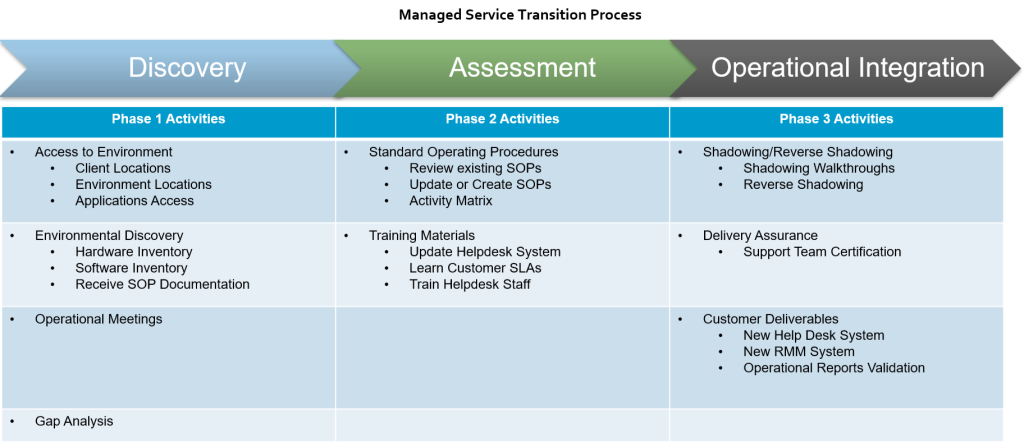
The desire to switch IT Support MSPs (Managed Service Providers) is fairly common in businesses worldwide, and yet a significant number of businesses are afraid to make this change. Why you ask? While in some cases it comes down to “The devil you know versus the devil you don’t”, but more frequently, businesses are afraid of the transition process of replacing their current IT services. While it is true that the transition process can be complex, but when executed strategically by a good MSP, it can lead to improved service quality, cost savings, and productivity enhancements.
At CRES Technology, since we specialize in IT Services, we are frequently involved in service transition with current MSPs or internal IT of our new customers. In this article, we will discuss the CRES IT Services Transition Process, exploring its purpose, methodology, and benefits. We’ll also discuss how our team can assist our customers in making a seamless switch.
Why Switch MSPs?
Before we dive into our IT Services Transition Process, let’s understand why organizations choose to switch MSPs:
- Performance Problems: You need to look for other options if your current MSP is not delivering on Service Level Agreements (SLAs), having frequent outages, or responding slowly to critical issues.
- Cost Efficiency: You can save money by switching MSPs. A new provider may have better pricing, scalability, and billing practices.
- Technological Improvements: Your IT needs change as technology changes. A new MSP can offer new perspectives, tools, and solutions for your IT challenges.
- Strategic Alignment: Your business goals and IT strategy may have changed. Switching MSPs lets you match your IT services with your organizational goals.
CRES IT Services Transition Process
The CRES IT Transition Process is a strategic framework designed by CRES Technology to ensure that transition takes place smoothly without service disruption for our new customers. Our overall process is divided into three logical phases. The activities in these phases are carried out via our own time-proven custom developed Workflow Management tool. Let’s dive into the details:

Phase 1: Discovery
The journey begins with understanding the client’s environment. Key steps include:
- Environmental Access: Gaining access to the existing IT environment.
- Client Locations: Identifying where our client’s physical offices are located. This helps tailor services to their specific needs.
- Network and Infrastructure Environment: Mapping out the physical locations of servers, workstations, and other IT assets.
- Applications Access: Gain access to support business and system applications. This helps ensure seamless continuity during the transition.
- Environmental Discovery: Gathering detailed information about the current setup, including hardware, software, and configurations.
- Hardware Inventory: Automatically gain access to connected hardware inventory via RMM agent, and supplement it with disconnected hardware inventory. This includes inventory of software installed on workstations and servers.
- Software Inventory: Documenting inventory of software applications.
- Receive SOP Documentation: Obtain existing Standard Operating Procedures (SOPs) from the previous MSP, if possible or available.
- Operational Meetings: Conduct meetings to align expectations, understand pain points, and define success criteria.
- Gap Analysis: Identify gaps between the current state and desired outcomes. Pinpoint areas for improvement.
Phase 2: Assessment
This phase focuses on evaluating existing processes and defining the path forward:
- Standard Operating Procedures (SOPs):
- Review existing SOPs to understand current processes.
- Update or create new SOPs to align with the transition and ideal future state.
- Activity Matrix:
- Define roles and responsibilities.
- Ensure clarity on who handles what tasks and how.
- Update Helpdesk System:
- Enhance the helpdesk system for efficient ticket management.
- Streamline communication channels.
Phase 3: Operational Integration
Now it’s time to put the plan into action:
- Shadowing/Reverse Shadowing:
- Observe and learn from existing processes.
- Understand day-to-day operations and pain points.
- Customer Deliverables:
- Provide value to clients during the transition.
- Communicate changes effectively.
- Implement New Systems:
- Help Desk System: Deploy an improved helpdesk system for better incident management.
- Remote Monitoring and Management (RMM) System: Enhance proactive monitoring and maintenance.
- Operational Reports Validation:
- Validate and optimize operational reports.
- Ensure accurate data for decision-making.
How do we do this?
Using our internally developed Workflow Management Software, CRES Team meticulously executes the transition plan. By understanding your unique needs, we tailor solutions that align with your business goals. Our strategic roadmap guides the transition process, ensuring minimal disruptions and maintaining business continuity.
Benefits of the CRES IT Services Transition Process
The CRES IT transition process offers several compelling benefits for organizations seeking to switch MSPs. Here’s a concise overview:
- Smooth Transition: By minimizing disruptions during the switch, the transition process ensures business continuity. Employees can seamlessly adapt to the new Helpdesk without significant downtime.
- Improved Efficiency: Streamlined procedures lead to faster issue resolution and better service delivery. If there is Internal IT Management, they can focus on strategic tasks rather than firefighting operational challenges.
- Cost Savings: The transition process allows organizations to optimize costs by eliminating inefficiencies. Renegotiating contracts result in financial gains.
- Enhanced Security: New Helpdesk often comes with improved security features. Organizations benefit from strengthened protection against cyber threats and vulnerabilities.
- Scalability: Aligning IT services with business growth becomes more manageable. The transition process sets the stage for scalable solutions that adapt to evolving needs.
- Risk Mitigation: Proper planning reduces risks associated with change.
- Client Satisfaction: A smooth transition ensures client satisfaction.
About CRES Technology
We are a technology company with deep expertise in IT services and software solutions. With our technology specialization and business knowledge, we can help you overcome operational challenges. We can also enhance your productivity by implementing software solutions that consolidate your data, documents, business processes, and business intelligence to enhance your productivity.
Many of our clients struggled with managing their data and documents and finding experienced people to manage their IT. As their company grew, so did their operational and productivity challenges. This is where our services benefit our customers.
Our service approach is to be proactive. Which means we take actions to prevent problems, unlike most MSPs. Our goal is to have the least number of support tickets, which can only be accomplished by being proactive.
About Rehan Ahmed

CRES Technology – Manager Business Analysis
As a versatile professional, Rehan leads the business development team for sales and marketing strategies, digital marketing, client relationship management, and contract negotiations.
Need more details? Contact Us
We are here to assist. Contact us by phone, email, or via our social media channels.